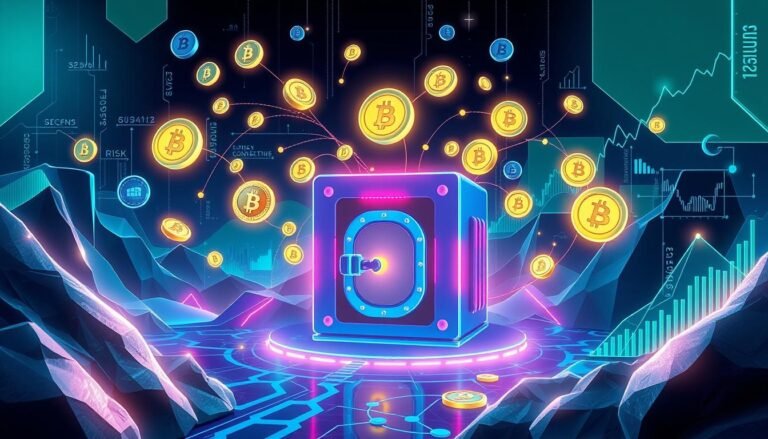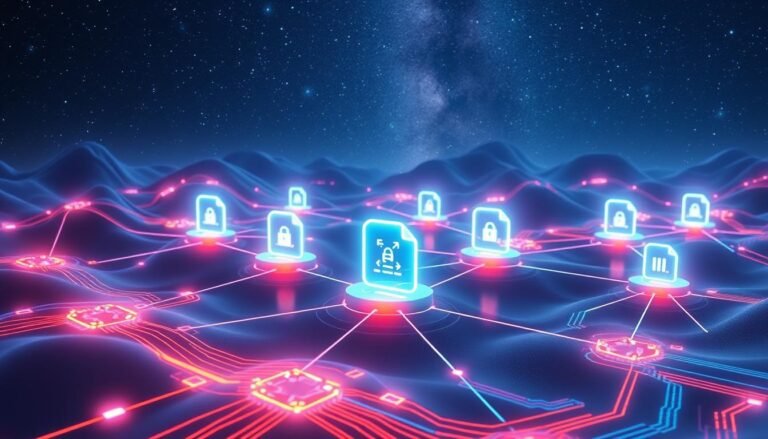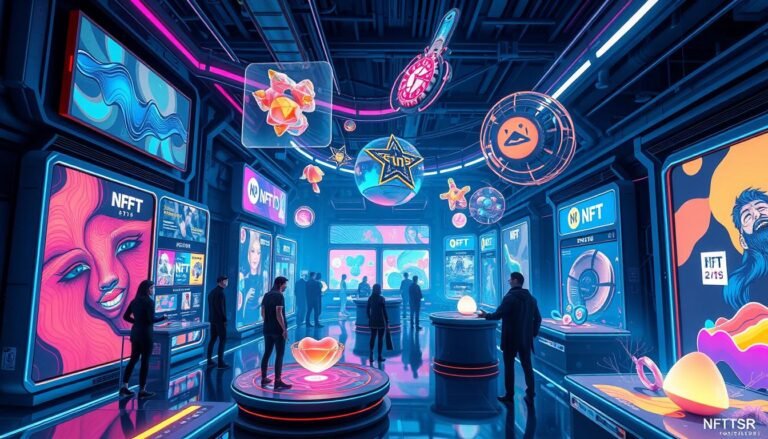Web3 Explained: The Internet’s Next Frontier
The internet is on the verge of a big change, entering a new era called Web3. Business authors Alex Tapscott and Steve Kaczynski say Web3 is the “Read-Write-Own Web.” It’s a place where people can own digital stuff, like money and identities, and trade with each other directly.
This new frontier uses advanced tech like blockchain, cryptocurrencies, and NFTs. It’s going to change how we use the internet and the way we make money.
Web3 brings many new ideas, like the metaverse, DAOs, DeFi, and self-sovereign identity. It wants to give users more power over their online lives. This is different from today’s internet, which is mostly controlled by big companies.
Key Takeaways
- Web3 is a decentralized internet where people can own digital assets and identities.
- It’s powered by blockchain, cryptocurrencies, and NFTs, aiming to shake up old business models.
- Web3 includes the metaverse, DAOs, DeFi, and self-sovereign identity, giving users more control.
- The move to Web3 is seen as a major change, like the invention of double-entry bookkeeping.
- Top industry leaders say “Web3: Charting the Internet’s Next Economic and Cultural Frontier” is a must-read for the future of the internet.
What is Web3?
The world wide web has changed a lot. It started as a “Read-only Web” (Web 1.0) where people just looked at information. Then, it became the “Read-Write Web” (Web 2.0) where people could also create content. Now, Web3 is about the “Read-Write-Own Web,” where users can own their digital stuff and content. This is thanks to blockchain technology.
In Web3, the power moves from big platforms to the users. This means more ownership, privacy, and monetization for digital items.
The Evolution of the World Wide Web
The internet has seen big changes. Web 1.0 started around 1994 with simple HTML pages. It had little interaction and no online money.
Web 2.0 came in 2004. It brought more social stuff, music, videos, and online money. This was because the internet got faster and better.
Web3 began in 2008 with Bitcoin and blockchain. It’s a big change towards a decentralized internet. Now, users can own their digital stuff.
The Decentralized, User-Controlled Internet
- Ownership through NFTs: Web3 makes owning digital assets easy with NFTs. It proves you own something on the blockchain.
- No Censorship: Web3 lowers the chance of censorship. It lets creators control their work.
- DAOs Autonomy: DAOs mean everyone can decide together. This makes things more open and fair.
- Identity Management: Web3 makes it easier to manage your online identity. It uses Ethereum addresses and the Ethereum Name Service.
- Direct Payments: Web3 lets you pay directly with cryptocurrencies like ETH. This makes the digital world more open.
Web3 is all about a more decentralized and user-controlled internet. It’s about giving people more power over their digital lives.
“Web3 represents the ‘Read-Write-Own Web’ – a decentralized internet where users can own their digital assets and content through technologies like blockchain.”
Web3 Explained: The Internet’s Next Frontier
Web3 is the next big step in the internet’s evolution. It promises to change how we interact online, own digital items, and do business. Using blockchain, cryptocurrencies, and other decentralized tech, Web3 aims to put users in charge of their data and digital assets. This shift could shake up old business models and open doors for new ideas, community-driven platforms, and digital experiences focused on users.
A survey by Synergy Research Group shows Amazon, Google, and Microsoft control 73% of cloud data storage. This highlights the internet’s current centralization. Web3 wants to change this by connecting data in a decentralized way. It also plans to make digital systems understand and use data in a way that’s transparent and controlled by users.
The finance sector is already feeling the impact of Decentralized Finance (DeFi). It’s bringing a more efficient and clear financial system with lower costs and fewer middlemen. Web3 is also set to transform the gaming world. It will make the Metaverse more secure and allow for the tokenization of in-game items.
| Web3 Statistics | Value |
|---|---|
| Views on the article “Web3 Explained: The Internet’s Next Frontier” | 197 |
| Course on Building Web3 Businesses debuted | Spring |
| Short Intensive Program on Web3 | January 2023 |
Various educational programs are diving into the tech behind Web3, like blockchain networks, cryptocurrencies, and smart contracts. Courses like “Building Web3 Businesses” and an MBA elective on Web3 are teaching students about Web3’s impact on business. They cover how it changes business models, competition, consumer welfare, challenges, and regulatory issues.
As the internet evolves, businesses are trying to keep up by using Web3’s capabilities. With its potential to change many industries, Web3 is seen as a key part of the future of business.
Key Technologies Enabling Web3
The core of Web3 includes blockchain networks, cryptocurrencies, non-fungible tokens (NFTs), and smart contracts. These technologies are changing the internet. They bring decentralization, transparency, and more control to users.
Blockchain Networks
Blockchain is key to Web3. It offers a secure, shared ledger that ensures everything is transparent and unchangeable. This system is the base for many Web3 apps. It makes transactions safe and cuts out middlemen.
Cryptocurrencies and NFTs
Cryptocurrencies like Bitcoin and Ethereum let us trade value without banks. They’re changing the world economy. NFTs let us own and trade unique digital items. This changes how we deal with digital content.
Smart Contracts
Smart contracts run on blockchain. They automate tasks and follow rules without needing middlemen. This could change many industries, from finance to supply chains.
These technologies form the base of Web3. They give users more control, privacy, and security online. As blockchain and Web3 grow, the internet is set for a big change towards being more open and user-focused.
“Web3 is already the fastest rate of adoption of any technology in human history.”
Web3 Applications and Use Cases
Web3 is changing many industries, from finance to the metaverse. It uses blockchain, cryptocurrencies, and NFTs to change how we use the internet. This makes our digital world more interactive and open.
Decentralized Finance (DeFi)
DeFi is a key part of Web3. It uses blockchain and cryptocurrencies for things like lending and trading. This way, people can manage their money without banks, making finance more open and fair.
The Metaverse
The metaverse mixes real and virtual worlds. It lets people own and trade digital items and join virtual economies. This world is full of new experiences and chances for creativity and teamwork.
Web3 apps are changing how we use the internet. They open up new ways for innovation and for people to take control of their digital lives. This is reshaping many industries and our digital experiences.
“The metaverse represents a vision of the future where digital and physical worlds converge, empowering users to own, create, and participate in virtual economies like never before.”
The Business Potential of Web3
The internet is changing from Web2 to Web3, bringing big changes to business. Web3 uses blockchain, cryptocurrencies, and decentralized platforms. It opens up new ways for companies to make money and create new business models.
Web3 lets businesses use decentralized networks and digital assets owned by users. This change helps both companies and individuals. It lets them join the growing creator economy and explore new markets.
New Business Models and Revenue Streams
Web3 gives businesses a chance to find new ways to make money. They can create platforms that rely on decentralized networks and digital assets. This way, they can connect directly with customers, build stronger relationships, and find new ways to earn.
Also, using blockchain, cryptocurrencies, and NFTs can lead to new income sources. Businesses can sell digital items, offer special experiences, or even turn physical things into digital assets. This opens up new ways to exchange value.
| Web3 Business Potential | Potential Impact |
|---|---|
| Decentralized Platforms | Empowers businesses and individuals to participate in the growing creator economy and tap into the expanding market for decentralized applications and platforms. |
| Cryptocurrencies and NFTs | Enables businesses to create and sell digital assets, offering unique and exclusive experiences to their customers, or even tokenize physical assets to unlock new forms of value exchange. |
| Community-Driven Models | Allows businesses to engage with their customers in a more direct and transparent manner, fostering stronger brand loyalty and creating new avenues for monetization. |
As web3 grows, companies that adapt will have a big advantage. They’ll be ready to take advantage of the new chances and money-making paths the decentralized internet offers.
Challenges and Risks of Web3
Web3 is promising, but it faces big challenges and risks. Issues like regulatory concerns, security problems, and making users adopt it are major hurdles. These obstacles need to be solved for Web3 to succeed.
Regulatory Concerns and Adoption Barriers
Regulatory uncertainty is a big problem for Web3. Governments are still figuring out how to handle cryptocurrencies, NFTs, and dApps. This confusion makes it hard for Web3 businesses to follow rules and slows down adoption.
Web3 is also hard for people who are used to Web2. It needs a lot of education to make it easier for everyone. Teaching people about private keys, governance, and Web3 is key to getting more people involved.
Security Vulnerabilities and Governance Challenges
Web3’s decentralized nature brings security risks and governance challenges. Smart contract bugs, like the DAO hack, can cause big losses. Keeping user data safe from phishing and other threats is also a big challenge.
Web3’s governance models can make it hard to make decisions and hold people accountable. Fixing these issues is vital for building trust in Web3.
| Web3 Challenge | Description |
|---|---|
| Regulatory Uncertainty | Lack of clear regulations around cryptocurrencies, NFTs, and dApps, leading to compliance challenges and slower adoption. |
| User Adoption Barriers | Complexity of Web3 technologies, requiring extensive user education to overcome the hurdle of transitioning from Web2 platforms. |
| Security Vulnerabilities | Risks of smart contract flaws, private key management, and phishing attacks, potentially resulting in the loss of digital assets. |
| Governance Challenges | Decentralized decision-making and accountability issues that can impact the stability and security of Web3 networks. |
| Data Availability and Integrity | Ensuring the availability and consistency of data distributed across Web3 networks, vital for network functionality. |
Fixing these web3 challenges, regulatory concerns, and adoption barriers is crucial. It will help crypto and blockchain-based Web3 technologies succeed and become more widely used.
Conclusion
Web3 is the next big thing in the internet world. It’s changing how we use digital content, own assets, and join online economies. Thanks to blockchain and other tech, Web3 gives power back to users, not just big companies.
But, there are still big challenges to overcome. Web3 needs to get past rules and get more people using it. Yet, its power to change business and help people is clear.
As we move to a more user-friendly internet, we all need to get on board. Web3 means a fairer online space where you own your data. It also makes the internet safer by not relying on one place.
Web3 and DeFi are making finance better for everyone. They bring new ways to trade, lend, and manage assets. This shows Web3’s big impact on many fields.
But, we must tackle rules and make it easy for everyone to use. This will help Web3 become a big part of our future internet.
Source Links
- Web3: Charting the Internet’s Next Economic and Cultural Frontier
- Mobavenue » Web 3.0 Explained: The Internet’s Next Frontier
- Web 3: The Next Frontier of the Internet?
- What is Web3?
- What is Web3? | Chainlink
- What is Web3? A Complete Guide to the Future of the Internet
- The Internet’s Next Frontier
- Understanding Web3: The Future of the Internet
- Web3 Technologies: The Next Frontier in Internet Evolution
- Unveiling The Next Frontier Of The Internet: An Introduction To The World Of Web3 | Entrepreneur
- Unlocking Web3: The Next Internet Frontier – Whimsy Games
- Web3 beyond the hype
- Web3: Charting the Internet’s Next Economic and Cultural Frontier: Podcast Ep. 77 – Chainalysis
- The Potential of Web3 in Streamlining B2B Collaboration
- How Web3 Security Concerns Might Impact You
- A Beginner’s Guide to Web3 Security – JKCP.com: Just Keep Carving Paths
- Web3: The Next Frontier – A Deep Dive into Big Tech’s Blockchain Projects
- Web3 for Everyone: Navigating the New Internet Frontier
- DeFi vs Web3 Explained: Unraveling Blockchain’s Next Frontier






